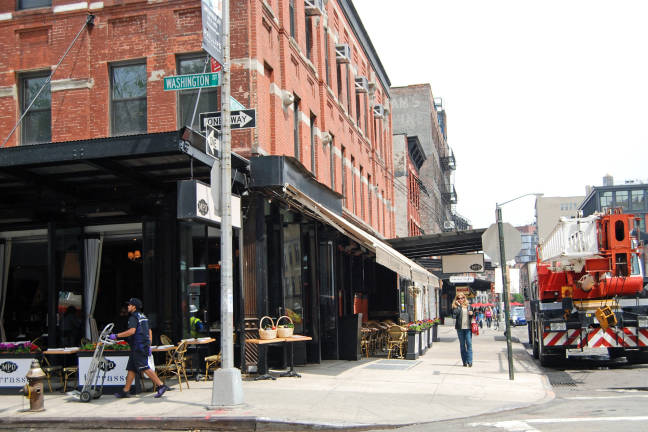A setback for gansevoort News

The Gansevoort Market Historic District in Greenwich Village, though small, contains a lot of history, which is why the surrounding community was so disappointed when the Landmarks Preservation Commission approved a developer's plan to revamp a block of Gansevoort Street between Washington and Greenwich streets.
Located just inside the district and just outside the Greenwich Village Historic District, the three buildings in question -- 46-50, 52-58 and 62-74 Gansevoort Street -- were built in 1939, 1854 and 1942, respectively, and currently house several restaurants and retail stores. The new development will sharply raise the heights of several of the buildings and revamp their facades.
Zach Weinstein, who has been fighting landmarking and zoning battles in the area for 25 years, was at the meeting June 7 to protest the development. “What people think of when they think of that district are these one- and two-story market buildings,” said Weinstein, who co-founded a group called Save Gansevoort. “Low structures with the big flat awnings in front and rails to move the carcasses around.” He and approximately 30 of his fellow community members held up signs during the meeting indicating their disapproval for the development.
Ultimately, the Landmarks Preservation Commission approved Aurora Capital's plans, which Aurora had revised after an earlier version of the project was rejected by the commission in February. The approved plans claim to imitate the taller tenement buildings that existed in the 1800s before the area became known for shorter, industrial buildings. The tallest of Aurora's proposed buildings would stand at 97 feet, but opponents cite historical documents saying none of the long-ago tenements were ever that tall. “I think [the developers] have really rationalized an approach for the blockfront development which allows for preservation as well as development,” commission Chairman Meenakshi Srinivasan said last Tuesday. She acknowledged the historical character of the area but concluded that the developers had done a good job taking the commission's earlier concerns into account.
Jared Epstein, vice president and principal of Aurora, told Our Town that construction would begin once the necessary permits are obtained by the Department of Buildings and would last roughly 24 months at most. "We have always said this neighborhood has not one, but many histories," Epstein wrote in an email. "Those histories have been lost over time, and by restoring and recreating elements of these periods, we believe this plan will help New Yorkers build deeper connections to their city." He added that they have already had a "diverse range" of businesses express interest in moving there once the new development is completed.
This is not the first time the area's historic buildings have been threatened. In 2003, Weinstein was a part of another effort to protect the Gansevoort Market Historic District when a developer wanted to amend the zoning code to allow for uses besides the traditional manufacturing. Though opponents did not get everything they wanted out of that fight, they did manage to get the City Council to prohibit office use, which would have attracted many developers to the area.
“The community's concern was that doing so would create economic incentive to start building huge additions on top of those buildings,” Weinstein said. “It's an intact block of one- to two-story market buildings, which is what makes it so special, but any time you've got low-rise buildings in Manhattan someone's going to want to try to build them up a lot higher.”
After the decision last week, Save Gansevoort released a statement saying they were “deeply disappointed,” but would not give up. “In this day and age, it is disconcerting that even our landmarked areas are no longer protected,” the statement read. “We urge the City Planning Commission and the City Council to block any amendments to the restrictive declaration on these sites that would permit the use of these buildings for office space.”